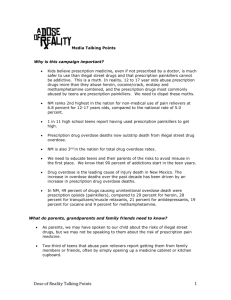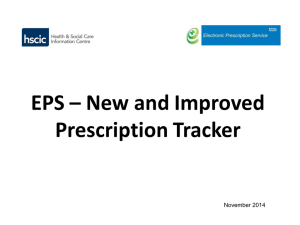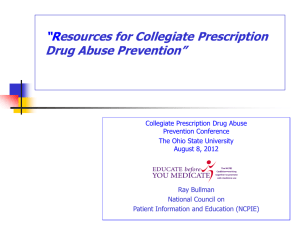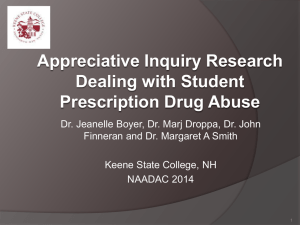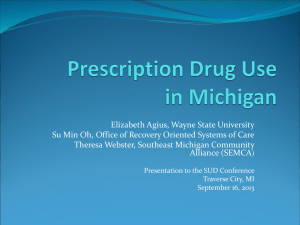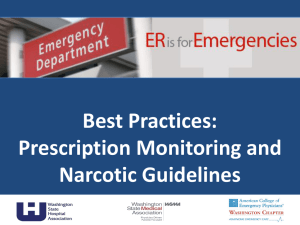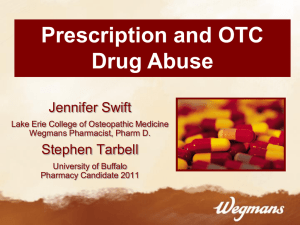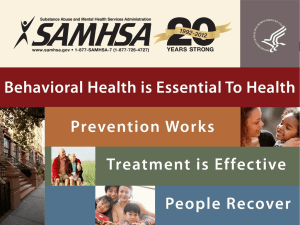Prescription Drug Abuse: Strategies to Stop the Epidemic 2013
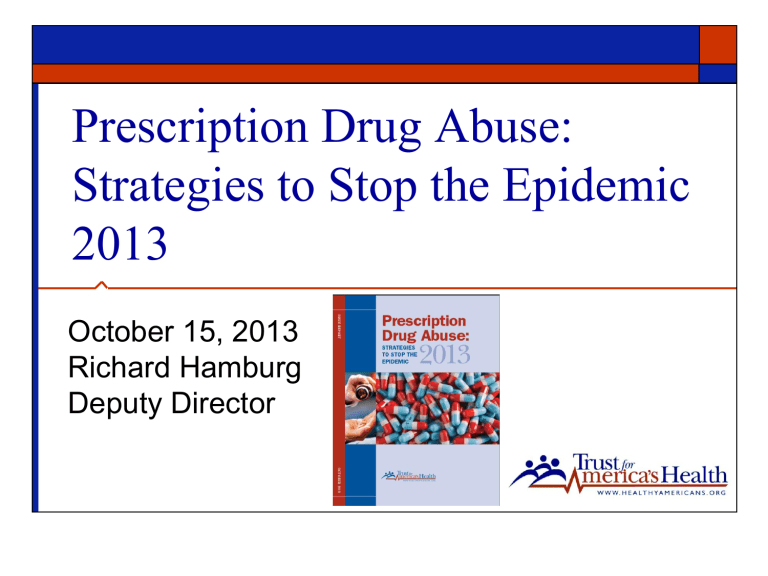
Prescription Drug Abuse:
Strategies to Stop the Epidemic
2013
October 15, 2013
Richard Hamburg
Deputy Director
About TFAH: Who We Are
Trust for America’s Health (TFAH) is a non-profit, non-partisan organization dedicated to saving lives by protecting the health of every community and working to make disease prevention a national priority.
The Facts
Prescription drug abuse has quickly become a top public health concern.
The sale of prescription painkillers have quadrupled over the past decade and, correspondingly, the # of prescription drug overdose deaths is now
16,000/yr., together with approximately 145,000 emergency room visits
Overall drug overdose deaths - a majority of which are from prescription drugs - doubled in 29 states since 1999, tripled in 10 and quadrupled in 4.
Prescription drug related deaths now outnumber those from heroin and cocaine combined, and drug overdose deaths exceed motor vehicle-related deaths in 29 states and Washington, D.C.
Misuse and abuse of prescription drugs costs the country an estimated
$53.4 billion a year in lost productivity, medical costs and criminal justice costs, and currently only one in 10 Americans with a substance abuse disorder receives treatment.
High Risk Groups
Men 25-54 have the highest rates of prescription drug overdose, and are around twice as likely to die than women 25-54
Over the past decade, prescription drug overdoses increasing much more among women than men. Can also affect newborns
People in rural counties are twice as likely to overdose on prescription drugs than those in big cities. Prescription drug abuse has quickly become a top public health concern.
One in four teens has misused or abuse a prescription drug at least once in their lifetime.
One in 12 reported nonmedical use of Vicodin, and one in 20, OxyContin.
The number of veterans receiving painkiller prescriptions is continuing to rise, as is risk for corresponding drug abuse.
Summary of state-by-state drug abuse mortality rates
Appalachia and the Southwest Have the Highest Overdose Death
Rates: West Virginia had the highest number of drug overdose deaths, at
28.9 per every 100,000 people - a 605 percent increase from 1999, when the rate was only 4.1 per every 100,000. North Dakota had the lowest rate at 3.4 per every 100,000 people. Rates are lowest in the Midwestern states.
The top five rates (per 100,000 population) are:
West Virginia, 28.9; New Mexico, 23.8; Kentucky, 23.6; Nevada, 20.7; and
Oklahoma, 19.4.
The lowest five rates (per 100,000 population) are:
North Dakota, 3.4; South Dakota, 6.3; Nebraska, 6.7; Virginia, 6.8;
Minnesota, 7.3.
Ranking State Rx Abuse and Misuse Laws
Rx abuse and misuse laws vary in states
Report includes a series of 10 indicators on a range of evidence-informed polices in place in different states --
10 out of 10: New Mexico and Vermont
9 out of 10: Kentucky, Massachusetts, New York and Washington
8 out of 10: California, Colorado, Connecticut, Delaware, Illinois, Minnesota, North
Carolina, Oklahoma, Oregon, Rhode Island and West Virginia
7 out of 10: Florida, Nevada, New Jersey, Tennessee and Virginia
6 out of 10: Arkansas, District of Columbia, Georgia, Hawaii, Iowa, Louisiana, Maryland,
Michigan, North Dakota, Ohio, Texas and Utah
5 out of 10: Alaska, Idaho, Indiana, Maine, Mississippi, Montana, New Hampshire and
South Carolina
4 out of 10: Alabama, Arizona, Kansas, Pennsylvania, Wisconsin and Wyoming
3 out of 10: Missouri and Nebraska
2 out of 10: South Dakota
Indicators explained
3.
4.
1.
2.
5.
6.
Prescription Drug Monitoring Program (PDMP): Does the state have an operational Prescription Drug Monitoring Program?
Mandatory Use of PDMP: Does the state require mandatory use of PDMPs by providers?
Doctor Shopping Law : Does the state have a doctor shopping statue?
Support for Substance Abuse Services: Has the state expanded Medicaid under the Affordable Care Act, thereby expanding coverage of substance abuse treatment?
Prescriber Education Requirement: Does the state require or recommend education for prescribers of pain medications?
Good Samaritan Law: Does the state have a law in place to provide a degree of immunity from criminal charges or mitigation of sentencing for an individual seeking help for themselves or others experiencing an overdose?
Indicators Continued
7.
8.
9.
10.
Support for Naloxone Use: Does the state have a law in place to expand access to, and use of, naloxone for overdosing individuals given by lay administrators
Physical Exam Requirement: Does the state require a healthcare provider to either conduct a physical exam of the patient, a screening for signs of substance abuse or have a bona fide patient-physician relationship that includes a physician examination, prior to prescribing prescription medications
ID Requirement: Does the state have a law requiring or permitting a pharmacist to ask for identification prior to dispensing a controlled substance?
Pharmacy Lock-In Program:
Does the state’s Medicaid plan have a pharmacy lock-in program that requires individuals suspected of misusing controlled substances to use a single prescriber and pharmacy?
Key Findings
Rescue Drug Laws: Just over one-third of states (17 and Washington, D.C.) have a law in place to expand access to, and use of naloxone - a prescription drug that can be effective in counteracting an overdose – including by lay administrators.
Good Samaritan Laws: Just over one-third of states (17 and Washington, D.C.) have laws in place to provide a degree of immunity from criminal charges or mitigation of sentencing for individuals seeking to help themselves or others experiencing an overdose.
Medical Provider Education Laws: Fewer than half of states (22) have laws that require or recommend education for healthcare providers who prescribe prescription pain medication.
Support for Substance Abuse Treatment: Nearly half of states (24 and Washington, D.C.) are participating in Medicaid Expansion - which helps expand coverage of substance abuse services and treatment.
ID Requirement: 32 states have a law requiring or permitting a pharmacist to require an ID prior to dispensing a controlled substance.
Prescription Drug Monitoring Programs: While nearly every state (49) has a Prescription
Drug Monitoring Program (PDMP) to help identify "doctor shoppers," problem prescribers and individuals in need of treatment, these programs vary dramatically in funding, use and capabilities. For instance, only 16 states require medical providers to use PMDPs.
Key Recommendations
Educate the public to understand the risks of prescription drug use to avoid misuse in the first place;
Ensure responsible prescribing practices, including increasing education of healthcare providers and prescribers to better understand how medications can be misused and to identify patients in need of treatment;
Increase understanding about safe storage of medication and proper disposal of unused medications, such as through "take back" programs;
Make sure patients do receive the pain and other medications they need, and that patients have access to safe and effective drugs;
More Key Recommendations
Improve, modernize and fully-fund Prescription Drug Monitoring
Programs, so they are real-time, interstate and incorporated into
Electronic Health Records, to quickly identify patients in need of treatment and connect them with appropriate care and identify doctor shoppers and problem prescribers;
Make rescue medications more widely available by increasing access for at-risk individuals to naloxone and provide immunity for individuals and others seeking help; and
Expand access to and availability of effective treatment options as a key component of any strategy to combat prescription drug abuse.
